小学英语三年级教学课堂实录
冀教版三年级上册Lesson 4 《Numbers 1-5》课堂教学实录

冀教版三年级上册Lesson 4 《Numbers 1-5》课堂教学实录Step1.Warming-up师:Do it.教师发指令。
Stand up!/Sit down!(教师可适当辅于手势。
)生:按教师指令做动作。
(学生通过听指令做动作环节,从心理上做好学习英语的准备。
)师:运用多媒体播放歌曲What’s your name?生:拍手跟唱所播放歌曲。
(通过跟唱英文歌曲这一情景给学生创设了英语课堂的氛围,激发学生学习英语的兴趣和热情。
)Step2.Revision and presentation师:通过问答方式复习所学句型What’s your/her/his name?生:回答问题并对其他同学进行提问复习所学句型。
师:用多媒体依次出示school,classroom,(desk,chair,book)的图片,并提问What’s this?生:看图片运用句型It’s a 。
并进行回答。
师:让学生仔细观察所给教室的图片,让其对desk,chair,book的数量进行统计,看谁数的既对又快,同时说出How many desks?How many chairs?How many books?生:认真观察图片并快速回答所数结果。
(用汉语回答数字)(通过问题引出短语how many,让学生初步准确理解其含义。
)师:多媒体出示课本所示一本书的单词图片并问How many books?生:对照图片回答老师的问题“一本书”(可以用汉语)师:引入one一词并板书单词,单独抽查几个学生。
生:跟读学习。
师:出示两本书的单词图片并指导学生学习two一词,抽查时两个同学为一组同时读two。
生:跟读学习。
师:依次出示图片指导学生学习three ,four, five。
生:跟读学习。
(通过问题引出数字。
数字为本课重点内容,除跟读老师学习读音还让学生两个、三个、四个一组站起来读数字,这样让学生从视觉上感受每个单词的含义,加深印象,更有助于学生的学习和掌握。
howareyou课堂实录三年级

howareyou课堂实录三年级摘要:一、课程导入1.问候学生并询问他们的近况2.通过游戏“你画我猜”复习已学过的词汇二、新课程内容1.学习问候语“How are you?”及其回答2.学习形容词“happy”、“sad”、“tired”和“excited”3.通过图片和生活场景练习新词汇三、课文学习1.朗读课文并理解大意2.学习生词和短语3.回答与课文相关的问题四、语法讲解1.讲解一般疑问句及其回答2.练习一般疑问句的提问和回答五、课堂活动1.角色扮演:学生用新学的词汇描述自己的心情2.小组竞赛:看哪个小组能最快完成心情词汇的连线题六、总结与作业1.回顾本节课所学的内容2.布置家庭作业:复习课文和词汇,准备下一次课的汇报演出正文:一、课程导入作为一名中文知识类写作助理,我今天要给大家分享的是关于三年级课堂实录的内容。
在这节课上,老师首先问候了学生并询问他们的近况,然后通过游戏“你画我猜”来复习之前学过的词汇,为接下来的新课程内容做铺垫。
二、新课程内容接下来,老师开始教授新的课程内容。
首先,他们学习了问候语“How are you?”以及其回答。
然后,学生们学习了形容词“happy”、“sad”、“tired”和“excited”,并通过图片和生活场景来练习这些新词汇。
三、课文学习在课文学习环节,学生们先朗读课文并理解大意,然后学习其中的生词和短语。
在理解课文的基础上,学生们还回答了与课文相关的问题,进一步巩固所学内容。
四、语法讲解在语法讲解环节,老师讲解了如何构成一般疑问句以及如何进行回答。
为了让学生更好地掌握这个知识点,老师还安排了练习环节,让学生提问和回答一般疑问句。
五、课堂活动课堂活动环节,老师安排了角色扮演和小组竞赛。
在角色扮演中,学生用新学的词汇描述自己的心情;在小组竞赛中,各个小组要尽快完成心情词汇的连线题,激发学生的学习兴趣。
六、总结与作业最后,老师对这节课的学习内容进行了总结,并布置了家庭作业。
三年级英语课堂实录
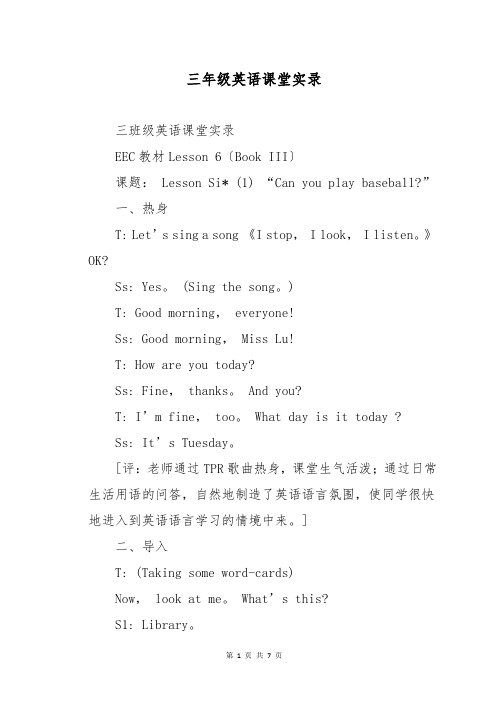
三年级英语课堂实录三班级英语课堂实录EEC教材Lesson 6〔Book III〕课题: Lesson Si* (1) “Can you play baseball?”一、热身T: Let’s sing a song 《I stop, I look, I listen。
》OK?Ss: Yes。
(Sing the song。
)T: Good morning, everyone!Ss: Good morning, Miss Lu!T: How are you today?Ss: Fine, thanks。
And you?T: I’m fine, too。
What day is it today ?Ss: It’s Tuesday。
[评:老师通过TPR歌曲热身,课堂生气活泼;通过日常生活用语的问答,自然地制造了英语语言氛围,使同学很快地进入到英语语言学习的情境中来。
]二、导入T: (Taking some word-cards)Now, look at me。
What’s this?S1: Library。
T: Very good。
Together, what’s this?Ss: Library。
T: Well done。
But how to spell?Ss: L—i—b—r—a—r—y。
(Then, review the words “ride bike violin piano ead ” in the same way。
)T: What do you do after school ?S1: I play the piano。
S2: I read an English book。
What do you do after school?S3: I ride my bike。
(Then, Ss ask and answer by each other。
)T: OK, class, please ask me 。
howareyou课堂实录三年级
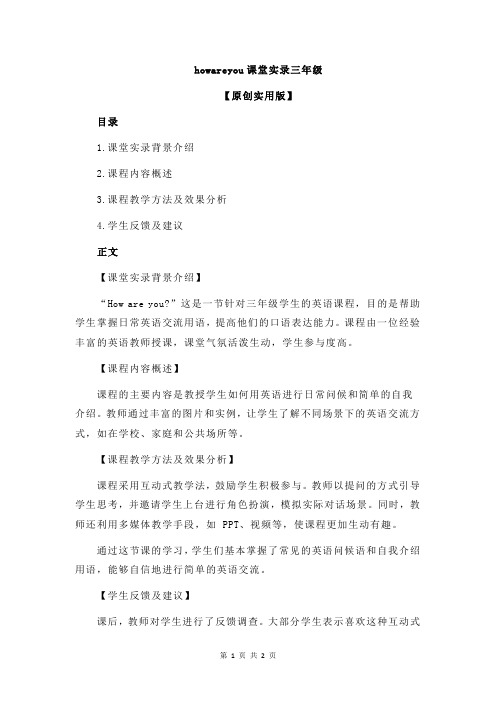
howareyou课堂实录三年级
【原创实用版】
目录
1.课堂实录背景介绍
2.课程内容概述
3.课程教学方法及效果分析
4.学生反馈及建议
正文
【课堂实录背景介绍】
“How are you?”这是一节针对三年级学生的英语课程,目的是帮助学生掌握日常英语交流用语,提高他们的口语表达能力。
课程由一位经验丰富的英语教师授课,课堂气氛活泼生动,学生参与度高。
【课程内容概述】
课程的主要内容是教授学生如何用英语进行日常问候和简单的自我介绍。
教师通过丰富的图片和实例,让学生了解不同场景下的英语交流方式,如在学校、家庭和公共场所等。
【课程教学方法及效果分析】
课程采用互动式教学法,鼓励学生积极参与。
教师以提问的方式引导学生思考,并邀请学生上台进行角色扮演,模拟实际对话场景。
同时,教师还利用多媒体教学手段,如 PPT、视频等,使课程更加生动有趣。
通过这节课的学习,学生们基本掌握了常见的英语问候语和自我介绍用语,能够自信地进行简单的英语交流。
【学生反馈及建议】
课后,教师对学生进行了反馈调查。
大部分学生表示喜欢这种互动式
的教学方式,觉得课程内容丰富有趣,有助于提高自己的英语口语能力。
但也有部分学生提出,希望教师能够在课堂上多进行一些语法讲解,以便更好地理解和运用所学知识。
总之,这节“How are you?”课程在提高学生英语口语能力方面取得了较好的效果。
冀教版三年级英语上册课堂实录
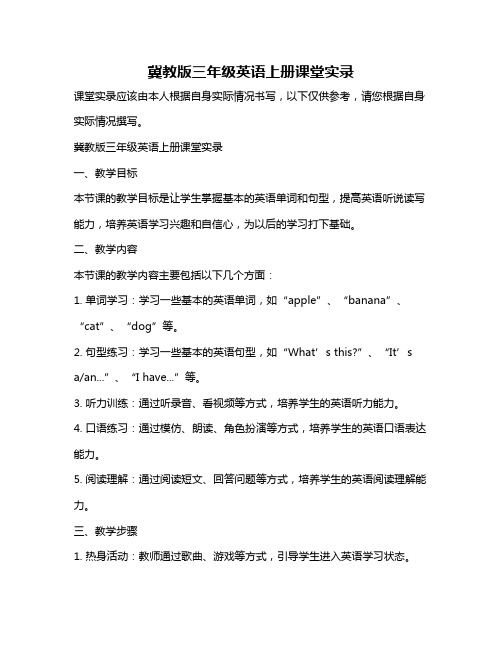
冀教版三年级英语上册课堂实录课堂实录应该由本人根据自身实际情况书写,以下仅供参考,请您根据自身实际情况撰写。
冀教版三年级英语上册课堂实录一、教学目标本节课的教学目标是让学生掌握基本的英语单词和句型,提高英语听说读写能力,培养英语学习兴趣和自信心,为以后的学习打下基础。
二、教学内容本节课的教学内容主要包括以下几个方面:1. 单词学习:学习一些基本的英语单词,如“apple”、“banana”、“cat”、“dog”等。
2. 句型练习:学习一些基本的英语句型,如“What’s this?”、“It’s a/an...”、“I have...”等。
3. 听力训练:通过听录音、看视频等方式,培养学生的英语听力能力。
4. 口语练习:通过模仿、朗读、角色扮演等方式,培养学生的英语口语表达能力。
5. 阅读理解:通过阅读短文、回答问题等方式,培养学生的英语阅读理解能力。
三、教学步骤1. 热身活动:教师通过歌曲、游戏等方式,引导学生进入英语学习状态。
2. 新课导入:教师通过实物、图片等方式,引导学生认识新单词和新句型。
3. 单词学习:教师通过示范、讲解、练习等方式,引导学生掌握新单词的发音、拼写和用法。
4. 句型练习:教师通过示范、讲解、练习等方式,引导学生掌握新句型的用法和表达方式。
5. 听力训练:教师通过播放录音、观看视频等方式,引导学生听懂英语材料中的信息。
6. 口语练习:教师通过模仿、朗读、角色扮演等方式,引导学生练习口语表达。
7. 阅读理解:教师通过阅读短文、回答问题等方式,引导学生理解英语材料中的信息。
8. 总结反馈:教师通过总结本节课的学习内容,引导学生回顾所学知识,并进行反馈和评价。
四、教学反思本节课的教学目标基本达成,学生在课堂上积极参与,表现出浓厚的学习兴趣和自信心。
但也存在一些不足之处,如部分学生发音不够准确、句型运用不够熟练等。
针对这些问题,教师在今后的教学中需要加强口语训练和句型练习,帮助学生更好地掌握英语知识。
三年级人教版英语 we love animals 课堂实录

课堂实录教学年级:小学三年级课题名题:We Love Animals教学版本:PEP小学英语课时说明:第2课时(30minutes)一、学生分析1、本案例适合小学三年级的学生,他们活泼好动,心理负担轻,好奇心强,学习态度积极,爱模仿,但注意时间短,自制力差。
2、学生经过一、二年级及该册前三单元的学习,已有了一定的基础,也掌握了一些常见的小动物和指令,能够说一些问候语和对话,听懂一些课堂用语和有秩序地进行教学游戏。
、学生对英语学习有着较为浓厚的兴趣,渴望通过新学期的学习获得更多的知识,以丰富自己的交际内容,提高自身的交际能力。
4、学生有了一定的英语动手能力和应用语言能力的课。
主要的学习内容就是课文中有关动物的单词和对话句型由于本课结合多媒体进行教学,为学生提供了比课本更生动更有趣更丰富的资源,更容易引起学生的兴趣,因此有助于激发与培养学生的想象力,使学生可以培养学生自主学习、自我创新的精神。
二、教材分析:1、本节课是小学英语PEP第一册第四单元第一课时,本节课所需课时为1课时,40分钟。
2、课前的学习内容,复习以前的情景对话。
3、有根据这一主要内容,我确定了本课的目标:重点为单词bear,dog,duck,pig,cat。
我采用了听、说、学和做的四步教学方法,利用先进的教学设备(CAI、投影仪),增强教学的趣味性和新颖性。
通过在“玩中学,学中玩”的愉快教学思路,将快乐贯穿于课堂教学中,设置了一个情景:参观喜洋洋的农场,来和小动物们交朋友。
三、教学目标:(一)、依据《标准》提出的五个目标,结合对学生和教材的分析结果,设定下以核心任务。
1,知识目标:掌握新单词bear ,dog ,duck ,pig,cat 会用“It’s a ……”2、能力目标:学会表演。
(Can act like some animals.)3、情感目标:爱动物、保护动物的情感。
Can love the animals and protect the animals.)(二)、本节课学生要达到的学习目标.能运用语言的能力、学会有关动物的单词和句型、能用英语口语表达和表演小动物、从`学习中体会保护动物。
人教PEP三下教学实录

人教PEP三下:Unit3 How many?第一课时教学实录教材版本、学科:人教PEP版,三年级英语下册一、教学设计1、学生分析:在学习本课时之前,三年级上学期已学习了1到10的数字单词,因此,学生对数字单词1到10的读音、拼写已经掌握。
2、内容分析:本课时的重点是:(1)在巩固数字1—10的基础上,学习数字eleven,twelve,thirteen,fourteen,fifteen。
(2)听懂有关数字的指令性语言并作出相应的反应。
本课时的难点是:能区别数字eleven,twelve,thirteen,fourteen,fifteen并正确发音。
本课时部分中的数字单词是本单元的导火线,贯穿整个单元的始终。
3、教学目标:一、知识目标1、掌握A部分Let’s learn中的单词。
2、能够听、说、认读A部分Let’s learn中的单词。
二、能力目标1、能听、说、认读1—15的数字单词,并能在日常生活中正确使用。
2、听懂有关数字的指令性语言并作出相应的反应。
三、过程与方法本单元以How many为主题,分为三个部分。
以A,B部分中的1—20的数字单词为线索,Let’s talk为桥梁,C部分中的任务活动为中心,贯穿整个单元。
四、情感态度与价值观1、养成热爱学习,懂得学习重在积累的优良品质。
2、注重小组合作学习,培养相互沟通忽然交流的能力。
4、教学策略1、以话题为线索组织活动。
教学中要以学生为主体,以话题为线索,以活动为中心。
将活动的设计、活动的准备、活动的展现等主动权交给学生,教师仅充当组织者、协调者的角色。
本单元以数字为主题,把形式多样的活动与数字串联起来。
围绕数字这一主题设计一系列活动,让学生在轻松愉快的情境中表达语言、感受语言、理解语言,从而习得语言。
2、活动要具多样性和多层次性。
教学活动中要对同桌(pairs)、小组(groups)、全班有合理的安排。
活动尽可能多地发挥学生的多元智能。
尊重学生个体差异,因材施教,面向全体学生进行分层次教学,使整个教学在和谐有序的气氛中进行。
三年级英语Unit 4 《Where is my car 》优质课公开课教案课堂教学实录

一、教学目标:1、能够听、说、认读单词:desk chair in on under2、能听懂会说:日常用语Where’s the ...? 及其 It’s in/on/under the ...3、让学生学会提问和回答物品所在的位置能在实际情境中运用.二、教学重难点:1、能够在图片、实物或者情景的帮助下运用句型:Where is the … ? It’s on /in/under the…询问物品位置并回答。
2、能够听、说、认读单词:chair desk in on under.三、教学过程Step 1 Warm-up教师带领学生说唱歌谣:《On in under》,引入帮Mike找东西的情境,复习已学学习用品、动物等物品。
Step2 Presentation1. 单词chair、desk的教学:1)多媒体出现桌子的图片:desk. 听音学说:“desk”.教师拼读法教读, 采用升降调的方式,用字卡操练读词: desk↗desk↘,并带读句子: This is my desk.2) 同样方法学习chair.3)师生齐表演chantWhere is your head?Here it is.Where is your arm?Here it is.Where is your desk?Here it is.Where is your chair?Here it is.4)举起一把尺子询问What’s this?结合课件询问Where is the ruler?2.句子Where is …? It’s … .及 on, in, under的教学:1)on的情境教学。
Look at blackboard.出示图片Look at the ruler. Where is the ruler? 引出句子It’s on the desk.领读“on”,借助手势教读,指生读. 高低音读。
师问:Where is the ruler?师示范指向It’s on the desk.再用实物结合,让学生感知on的位置,练习目标句型Where is the ruler? It’s on the desk.2) in的学习。
三年级英语上册unit4 课堂教学实录

打开矩形,看到Cat,齐读it’s a cat.
Ss :it’s a bear.
打开矩形看到bear,齐读it’s a bear.
Let’s act
老师动作上模仿小猪,并且说pig,I’m a pig .学生也模仿着小猪说pig,I’m a pig.
相同的又教大家模仿了其他动物。
Ss:ok!
观看并跟读视频,复习上一节课的内容。为新课热身
Step 2 presentation
Let’s learn
T:you’re great! Do you love animals? Today ,we’ll learn many animals课件出示课题,并且配图,让大家了解今天学习的和动物有关,明确主题。
T: let’s go to Old Macdonald’s farm. And tell me” I see…..”
学生观看歌曲,回答I see ……学生的回答有I see a duck.
I see Old MacDonald .等等
T:yes ,we can see some ducks, let’s see what animals on the farm.
pep三年级上册unit4 Alet’s learn let’s chant
一、教材分析
《pep人教版小学英语》(三年级上)完全是按照《全日制义务教育普通小学英语课程标准》的精神编写而成的,它积极提倡任务型教学原则,每个单元都围绕一个话题,让学生通过参与、思考、讨论、交流与合作等方式学习和使用英语,实现目标任务。
二、教学内容分析
新课程理念强调课堂小社会,生活大课堂,课堂生活化,生活即课堂。我在本节课的教学中,引导学生通过观察,交流,游戏的学习方式,把所学内容与真实场景联系起来,让学生在轻松愉快的氛围中学习真实的语言,使英语教学贴近生活,增加了任务教学和TPR教学,使学生动起来,。
PEP三年级下册英语教学实录[样例5]
![PEP三年级下册英语教学实录[样例5]](https://img.taocdn.com/s3/m/ee78411911661ed9ad51f01dc281e53a580251d4.png)
PEP三年级下册英语教学实录[样例5]第一篇:PEP三年级下册英语教学实录PEP小学英语三年级下Unit 6 ALet’ learn教学实录教材分析本课的教学内容是三年级下学期Unit 6 How many的第二课时主要要求学生掌握一个句型How many …do you see?I see…五个数字eleven, twelve,thirteen,fourteen,fifteen.掌握“询问数字”表达法,并能在实际学习和生活中运用。
学情分析三年级的学生通过半年的学习,对英语单词、句子的掌握有一定的基础。
本节课我会着重加强学生的口语交流,做到关注到每一位学生,不放过每一个学生。
教学目标(1)认知目标:掌握“询问数字”表达法,并能在实际学习和生活中运用。
(2)情感目标:能听懂、会说赞美别人物品的短句,如:so beautiful!教育学生要珍惜亲情,共同协作,共同进步。
(3)能力目标:培养学生听、说、指、读、写、画、演、做的能力和综合运用英语的能力。
教学重点:(1)能听懂,会说:How many…do you see? I see…(2)能熟练运用eleven twelve thirteen fourteen fifteen数字。
教学策略:通过歌谣或小诗,看实物或卡片以及做游戏,猜谜语等形式。
激活学习的语言,肢体动作,实物观察,语言交流等智能,让学生投入到学习过程中,让课堂充满乐趣。
教法、学法:本节课采用“夯基、激趣、合作、交流”的全新教学模式,使学生的学习进取心和动力经久不衰。
(1)唱英语歌曲,引发兴趣(2)创设情境,激发兴趣(3)游戏竞赛,促发兴趣(4)及时评价,保护兴趣(5)交流合作,巩固兴趣本课教学从激趣入手,循序渐进地达到学习目标。
整个教学体现全体参与,合作交流,实践探究。
小组展示,实践应用,个体创新。
在活动中开始,在情境中操作,在运用中创新,充分发挥学生的自主性,创造性。
教学评价采用师评,自评,学生互评和小组评价等形式。
《What time is it》课堂实录
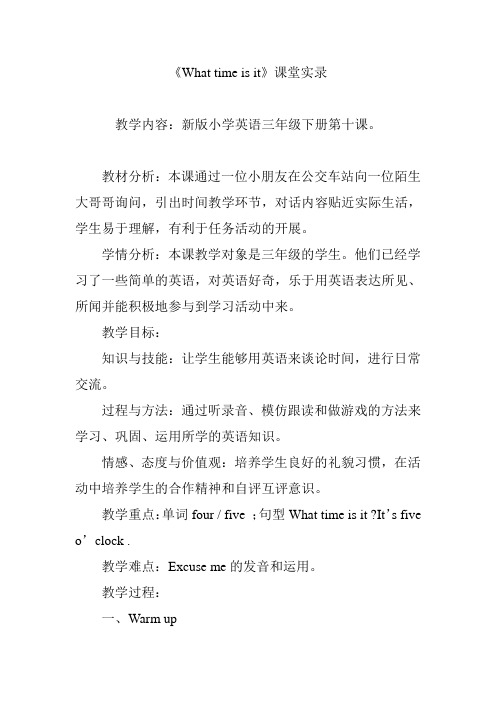
《What time is it》课堂实录教学内容:新版小学英语三年级下册第十课。
教材分析:本课通过一位小朋友在公交车站向一位陌生大哥哥询问,引出时间教学环节,对话内容贴近实际生活,学生易于理解,有利于任务活动的开展。
学情分析:本课教学对象是三年级的学生。
他们已经学习了一些简单的英语,对英语好奇,乐于用英语表达所见、所闻并能积极地参与到学习活动中来。
教学目标:知识与技能:让学生能够用英语来谈论时间,进行日常交流。
过程与方法:通过听录音、模仿跟读和做游戏的方法来学习、巩固、运用所学的英语知识。
情感、态度与价值观:培养学生良好的礼貌习惯,在活动中培养学生的合作精神和自评互评意识。
教学重点:单词four / five ;句型What time is it ?It’s five o’clock .教学难点:Excuse me的发音和运用。
教学过程:一、Warm up1.Sing a song 《Ten little Indians》.2.Guess .T: Please listen carefully then guess what’s this ?(播放时钟的声音)Ss:时钟。
T:能猜一猜本节课我们要学习的内容吗?Ss:是关于询问时间的吧。
T: Yes , you are right .二、Presentation1.T shows a clock and teaches the new words and new sentence .T: 时钟用英语说“clock”, please read after me.Ss: clock.T: 点钟就是“o’clock”, for example:三点钟就是three o’clock , 五点钟就是five o’clock.T: 你能试着说说吗?S1:一点钟one o’clock.S2: 九点钟nine o’clock.T: Good ! Now I have a clock , do you want to know what time the clock tells us ?T: If you want to know , please ask “What time is it ? ”T: OK.Now look at the clock , what time is it ?S: It’s one o’clock.T: What time is it ?S: It’s three o’clock.T: What time is it ? Who can try ?S: It’s two o’clock.T: What time is it ?Ss: It’s…T: 怎样来回答What time is it ?Ss: 用It’s + 时间2.Practice用滚动的“猜时刻”设置游戏(抢答竞赛):What time is it ?It’s …3.Look at your clocks , ask and answer with your partner .4.Teaches the phrase. ( 出现课文画面)T:同学们,这是哪里?S: 公交车站。
人教版三年级上册英语第三单元课堂实录
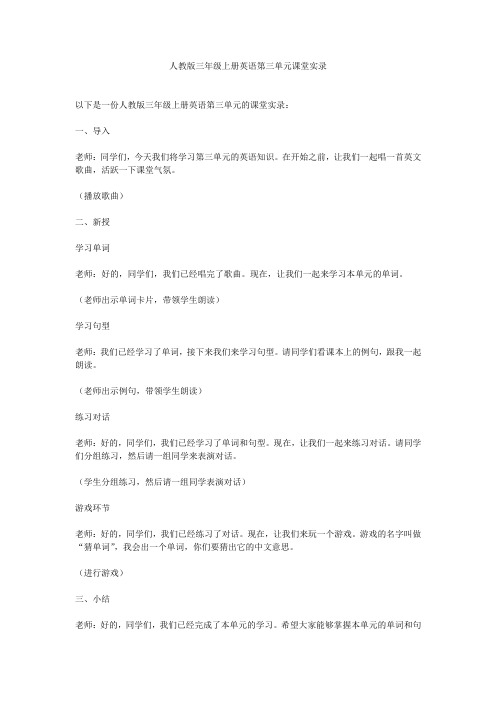
人教版三年级上册英语第三单元课堂实录
以下是一份人教版三年级上册英语第三单元的课堂实录:
一、导入
老师:同学们,今天我们将学习第三单元的英语知识。
在开始之前,让我们一起唱一首英文歌曲,活跃一下课堂气氛。
(播放歌曲)
二、新授
学习单词
老师:好的,同学们,我们已经唱完了歌曲。
现在,让我们一起来学习本单元的单词。
(老师出示单词卡片,带领学生朗读)
学习句型
老师:我们已经学习了单词,接下来我们来学习句型。
请同学们看课本上的例句,跟我一起朗读。
(老师出示例句,带领学生朗读)
练习对话
老师:好的,同学们,我们已经学习了单词和句型。
现在,让我们一起来练习对话。
请同学们分组练习,然后请一组同学来表演对话。
(学生分组练习,然后请一组同学表演对话)
游戏环节
老师:好的,同学们,我们已经练习了对话。
现在,让我们来玩一个游戏。
游戏的名字叫做“猜单词”,我会出一个单词,你们要猜出它的中文意思。
(进行游戏)
三、小结
老师:好的,同学们,我们已经完成了本单元的学习。
希望大家能够掌握本单元的单词和句
型,并且能够在实际生活中运用它们。
下课!
以上是一份人教版三年级上册英语第三单元的课堂实录,供您参考。
在实际教学中,您可以根据学生的实际情况和教学需要进行适当的调整和补充。
新人教版小学英语《绿野仙踪》教学实录

新人教版小学英语《绿野仙踪》教学实录引言本文档记录了教学者在小学英语课堂上使用新人教版《绿野仙踪》教材的实际教学情况和经验分享。
教学背景- 年级:小学三年级- 教材:新人教版《绿野仙踪》- 课时:10课时教学目标- 培养学生对英语研究的兴趣和自信心- 培养学生的听、说、读、写的综合能力- 研究并掌握与故事内容相关的英语单词和句型教学准备- 教材:新人教版《绿野仙踪》课本及配套练册- 多媒体设备、投影仪- 教学笔记及准备好的课堂活动教学步骤1. 导入:通过展示故事主人公的图片,激发学生对故事的兴趣。
2. 听说训练:播放故事的录音,让学生跟读,加深对故事的理解。
3. 词汇研究:教授故事中出现的重点单词,通过图片、示范等方式帮助学生记忆。
4. 阅读理解:指导学生阅读故事并回答相关问题,加强阅读能力。
5. 句型练:设计一些与故事相关的句型练,让学生熟练运用所学句型。
6. 语法点讲解:根据故事中的语言点,向学生讲解相关的语法知识。
7. 读写训练:要求学生通过模仿、填空等方式,进行读写练。
8. 小组合作:分组让学生进行对话、表演等活动,提高口语交流能力。
9. 课堂小结:总结本节课的研究内容,鼓励学生学以致用。
10. 作业布置:布置课后练和作业。
教学效果通过本套教学方案,学生在听、说、读、写的综合能力上有了明显的提高,对故事内容的理解更加深入,同时也增强了学生对英语研究的兴趣和自信心。
结语本文档总结了使用新人教版《绿野仙踪》教材进行小学英语教学的实际经验和教学方案。
这些经验和方案在教学实践中被证实是有效的,希望能对其他英语教学者提供一些参考和借鉴。
三年级下册英语教案、实录、反思、评价-Lesson13-人教精通版

三年级下册英语教案、实录、反思、评价Lesson13人教精通版一、教学目标1. 知识与技能:通过本课的学习,使学生能够正确理解和运用本课的单词和句型,提高学生的听说能力和日常交际能力。
2. 过程与方法:通过创设情境,让学生在真实语境中感知、理解和运用英语,培养学生运用英语进行日常交流的能力。
二、教学内容1. 词汇:学生能够听懂、会说、会读本课的单词,如:cat, dog, fish, bird等。
2. 句型:学生能够运用本课的句型进行日常交流,如:“I havea cat.” “Do you have a dog?”等。
3. 语法:学生能够理解并运用一般现在时态的肯定句和疑问句。
三、教学重点与难点1. 教学重点:学生能够正确理解和运用本课的单词和句型,提高学生的听说能力和日常交际能力。
2. 教学难点:一般现在时态的肯定句和疑问句的构成及运用。
四、教具与学具准备1. 教具:多媒体课件、单词卡片、录音机、磁带等。
2. 学具:英语课本、练习册、笔、纸等。
五、教学过程1. 热身:播放英语歌曲,营造英语氛围,激发学生的学习兴趣。
2. 导入:通过图片或实物展示本课的单词,引导学生学习并运用这些单词。
3. 新课呈现:通过创设情境,让学生在真实语境中感知、理解和运用英语。
4. 操练:设计各种活动,如:角色扮演、小组讨论、游戏等,让学生在实际操作中运用本课的单词和句型。
5. 巩固:通过练习题或小测验,检查学生对本课内容的掌握程度。
7. 作业布置:布置适量的作业,巩固所学内容。
六、板书设计1. Lesson 132. 词汇:cat, dog, fish, bird等3. 句型:I have a cat. Do you have a dog?等4. 语法:一般现在时态的肯定句和疑问句七、作业设计1. 听力练习:听录音,完成练习题。
2. 口语练习:模仿课文对话,进行角色扮演。
3. 写作练习:根据所学内容,编写小短文。
八、课后反思1. 教学方法是否恰当,是否能够激发学生的学习兴趣。
译林版三年级英语下册Unit3第一课时课堂实录

译林版三年级英语下册Unit3 第一课时课堂实录(转载)一、教学目标:1.能初步听懂、会说、会读日常用语和句型:This isn’t my pencil. Is this /that your pencil? Yes, it is. No, it isn’t.2.能初步听懂、会说、会读写词汇:school bag, pen, pencil, crayon, ruler, rubber, pencil case3.能初步听懂、会说、会用物主代词my, your。
4.树立团结友爱、帮助同学的助人为乐的精神,培养正确的价值观。
二、教学过程Step1. Warming up1.GreetingT:Hello, boys and girls!Ss:Hello, Miss Wu.T: You are good boys and girls. So don’t talk in class, OK?Ss: OK, Miss Wu.2. Sing a song“Don’t talk, Tom!”T:Great! Let’s sing a song, girls sing Tim’s part, boys sing Tom’s part. Let’s PK! Step2. Presentation1.教授一般疑问句Is this/that ...及肯定回答Yes, it is和否定回答No, it isn’t.a. Free talkT: Look! What’s this? (拿一本学生的英语书)Ss: It’s a book.T:Is this an English book? Ss: YesT: What’s that?(拿一本学生的语文或数学书)Ss: It’s a book, too.T: Is that an English book? Ss: No.b.教授句型出示句型---一般疑问句:Is this/that a/an ...?肯定回答:Yes, it is.否定回答:No, it isn’t.1)老师出示所学单词卡片进行操练2)PPT出示图片,根据图片同桌练习句型c. Free talkT: xxx. Is this your English book?S1: No, it isn’t.T: Oh,xxx. Is this your English book?S2: Yes, it is.T:Boys and girls, is this his/her book?Ss: Yes, it is.T: Here you are.S2: Thank you.d.教授句型出示句子----一般疑问句:Is this/that your/his/her...?回答:Yes, it is. No, it isn’t.PPT出示图片,根据图片同桌练习句型(√--Yes ×No)2.教授词汇T:Is this your rubber?S: Yes it is.T: What else do you have on your desk? S:....教授词汇:ruler, pencilShow a schoolbag and ask student:T:What’s this? ...Yes, it’s a schoolbag.教授schoolbag school+bag= schoolbag比较hot+dog= hotdogT: What’s in my school bag? xxx, please come here and open it. Touch, take out and say!S: ... 教授pencil case, pen, crayon.a. Read words- high and low voice.b.拼读c.老师拿讲台上从书包里拿出来的学习用品,让学生大声说。
英语人教版三年级上册课堂实录
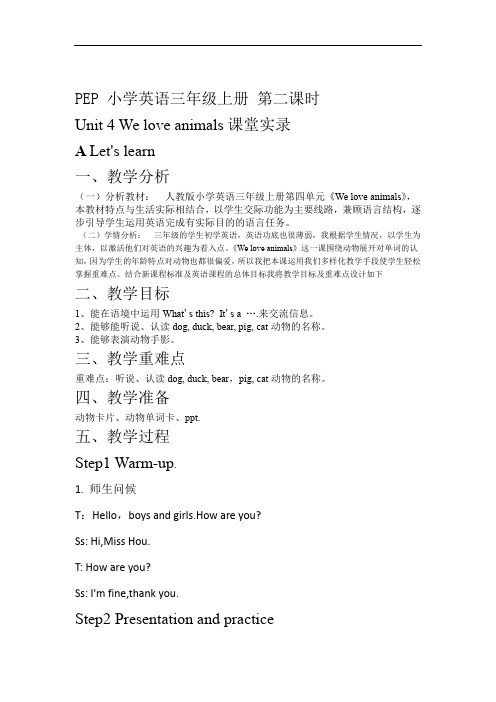
PEP 小学英语三年级上册第二课时Unit 4 We love animals课堂实录A Let's learn一、教学分析(一)分析教材:人教版小学英语三年级上册第四单元《We love animals》,本教材特点与生活实际相结合,以学生交际功能为主要线路,兼顾语言结构,逐步引导学生运用英语完成有实际目的的语言任务。
(二)学情分析:三年级的学生初学英语,英语功底也很薄弱,我根据学生情况,以学生为主体,以激活他们对英语的兴趣为着入点。
《We love animals》这一课围绕动物展开对单词的认知,因为学生的年龄特点对动物也都很偏爱,所以我把本课运用我们多样化教学手段使学生轻松掌握重难点。
结合新课程标准及英语课程的总体目标我将教学目标及重难点设计如下二、教学目标1、能在语境中运用What's this?It's a ….来交流信息。
2、能够能听说、认读dog, duck, bear, pig, cat动物的名称。
3、能够表演动物手影。
三、教学重难点重难点:听说、认读dog, duck, bear,pig, cat动物的名称。
四、教学准备动物卡片、动物单词卡、ppt.五、教学过程Step1 Warm-up.1. 师生问候T:Hello,boys and girls.How are you?Ss: Hi,Miss Hou.T: How are you?Ss: I'm fine,thank you.Step2 Presentation and practice位选手,有5同学们今天我班将举行一场选美大赛,现在我们先来认识这请第一位选手,未见其人,先闻其声。
1. Presentation和渗创设情景,老师播放动物叫声让学生猜动物名,从而引出本课的教学内容,句子。
透chant a. 老师播放动物叫声让学生猜动物名s this? What'T:(扮猫叫声并伴有动作)s a cat.Ss:It' cat并带读。
英语教学实录教案模板范文

课程名称: [课程名称,如:小学英语三年级下册 Unit 1 My Friends]教学对象: [年级和班级,如:三年级一班]教学时间: [具体日期和时间,如:2023年4月10日,星期一,第二节课]教学目标:1. 知识目标:- 学生能够正确认读并书写单词:friend, brother, sister, mother, father, brother, sister。
- 学生能够理解并运用句型:This is my friend. / This is my brother. / This is my sister. / This is my mother. / This is my father.2. 技能目标:- 学生能够通过图片和情境,运用所学词汇进行简单的对话。
- 学生能够通过小组活动,提高听说能力。
3. 情感目标:- 学生能够表达对家人和朋友的喜爱之情。
- 学生能够培养团队合作精神和交流能力。
教学重点:- 单词的认读和书写。
- 句型的理解和运用。
教学难点:- 句型的灵活运用。
- 在真实情境中运用所学知识进行交流。
教学准备:- 多媒体课件。
- 图片卡片。
- 小组活动材料。
- 学生练习本。
教学过程:一、导入 (5分钟)1. 歌曲导入:播放一首与朋友、家人相关的英文歌曲,激发学生学习兴趣。
2. 自由谈话:引导学生谈论自己的朋友和家人,为学习新内容做铺垫。
二、新课学习 (20分钟)1. 词汇教学:- 展示图片,引导学生说出相应的单词。
- 学生跟读单词,教师纠正发音。
- 通过游戏或练习,让学生书写单词。
2. 句型教学:- 教师示范句型,学生跟读。
- 学生练习句型,教师个别指导。
- 小组活动:学生分组,用所学句型进行对话。
3. 情境教学:- 创设情境,让学生运用所学知识进行交流。
- 教师引导学生观察图片,理解情境,并尝试用所学句型表达。
三、巩固练习 (10分钟)1. 游戏环节:- 猜单词游戏:教师说出一个单词,学生根据图片猜测。
- 1、下载文档前请自行甄别文档内容的完整性,平台不提供额外的编辑、内容补充、找答案等附加服务。
- 2、"仅部分预览"的文档,不可在线预览部分如存在完整性等问题,可反馈申请退款(可完整预览的文档不适用该条件!)。
- 3、如文档侵犯您的权益,请联系客服反馈,我们会尽快为您处理(人工客服工作时间:9:00-18:30)。
PEP人教版小学英语三年级课堂实录一、歌曲导入:T: Let's sing a song. The song's name is 《One little finger》.[评:教学热身是英语课堂TPR教学方法的重要形式之一,教师采用歌曲来缓解学生的紧张情绪,建立轻松和谐民主的课堂氛围,为进一步的学习奠定了良好的基础。
]二、师生问候:T: Class begins! Hello, everyone!Ss: Hello, Miss Cai! T: We all like the animals, but the zoo isn't really the animals home town. Where is their real home town?S:大自然。
T: Yes! Let's look at the animal in nature. OK?(观看多媒体影片)T: Do you like animals?Ss: Yes!T: The earth be longs to both animals and human beings. We should live peacefully together. We should try to give them a better living environment, and protect them from being hurt. Do you think so?Ss: Yes!T: OK! Let's begin from now on!T: The time is up. Good-bye everyone![评:结束语知识性与思想性融为一体,既强调了本课知识的重点,又对学生进行了思想教育,使学生对所学内容有了一个更高层次的认识,使英语教学的目的得以充分的发挥。
]评析:教者从学生的认知规律入手,由浅入深、由易到难,降低了英语语言学习的难度。
同时,充分利用头饰、卡片、图片、多媒体教学软件等直观教学手段,调动了学生多种感观投入到语言学习中来。
教者还利用TPR、歌曲、歌谣等活泼有趣的形式,增加了课堂教学的感染力,并采用实地应用语言的调查活动,提高了教学效果,达到了良好的教学反馈。
T: How are you to day?Ss: We're fine, thank you.T: What's the weather like today?Ss: It's fine.[评:简单的问候,可以帮助学生适应英语语感,使学生很自然地进入英语学习状态。
]三、新授知识:T: A lovely today, isn't it? I have a good news for you. We're going to visit the zoo. Are you happy?Ss: Yes!T: Today we'll learn a lesson about the zoo. Please tell me. Which lesson shall we learn?Ss: Lesson 9T: OK! Now, let's count from one to nine!(教师同时书写板书Lesson9)[评:在学生原有知识的基础上,以数字引入,使课题的出示别具特色,自然而不失趣味性。
]T: Well, who can tell me what you can find in the zoo?Ss: Monkeys, tigers, and hippos….T: Oh, we'll see so many animals. That's great! Now, please look here. We'll meet many animal friends today. What's this?(出示动物头饰)T: Do you have a monkey?S: No, I don't.T: Oh, Don't worry. This monkey is for you!(S1带上头饰)(以下lion, hippo, tiger, panda, elephant, dog, goat同上)T:Now, we have so many animals, they are our best friends! But look there, there is another friend. She's waiting to meet us. Who's she?(指向长颈鹿玩偶)Ss: Changjinglu.T: Yes, it's a Changjinglu, but in English it's a giraffe. Now, please say after me, “giraffe”!T: Look there, I have a beautiful picture, what's this?(贴出长颈鹿图)Ss: Giraffe.T: Yes, but how to spell it?(出示单词卡)Ss: “g-i-r-a-f-f-e”T: Let's sing a song, make a giraffe in the air.(师生同唱并拼写,教师指图)T: What's this?Ss: It's a giraffe.[评:运用头饰这一简单的教具,将学生喜爱的动物请到了课堂上来,使学生产生了浓厚的兴趣,使抽象化的词汇学习具体化,易化了词汇这一教学难点。
]T: We met so many animal friends. And would you like to go to the zoo with Tutu? Are you ready? Let's go! OK?Tand Ss: One, Two, Three, go.(师生同看多媒体投影)[评:从英语学科的实际特点出发,教者运用电脑多媒体再现课文内容,使学生有如身临其境,培养了学生的观察能力和语言应用能力。
]T: What did Jack say?Ss: "Look there!"T: Yes, Jack说“看那儿”,in English we should say, "Look there."T: Now, look at me please. Look there! It's a monkey. Look there! It's ahippo. Do you under stand? Please say after me.(教师手指教室内戴头饰的学生)T: Now, let's sing a song《One little finger》,but this time please sing that like me.(师生共同唱并手指相应的动物头饰)。
T:Now please point to ananimal, ask and answer in pairs.(学生分组练习)T:Well, please look at me please. Look there!(指向猴子)It's a monkey. I like monkeys(拿出心形单词卡)Do you under stand? What does it mean in Chinese? Ss:Xi huan.T:Yes. Please follow me. I like monkeys.(板书: like monkeys )T:OH. Now look there. There is a“s”, but why?(拿出单数卡)There is a monkey. Only one! So there's no“s”.(拿出复数卡)Wow, there are so many monkeys, then, we must addan“s”(利用多张卡片领学生练习这区分单词的单复数)T: Now, every one make a sentence like me, please.Ss: I like monkeys. I like elephants…T: Well, please listen to me carefully. Do you like monkeys? If you like, you can say ,“Yes, I do.”(师生练习句型)T: Let's play a game. I'll ask you “Do you like…?”If you like it, please stand up. [评:这部分内容是教学的难点,教师通过TPR教学法最大限度地引发学生积极学习的兴趣,使句型的操练这有一枯燥的演练形式兴趣化。
]T: Your pronunciations are fine. Now let's listen to the tape and read after it.(Listen and speak)[评:在英语教学中,原声语音的模仿是必不可少的步骤,有利于培养学生优美的语感,为英语的终身学习打下良好的基础。
]T: Ok, good job! But I'd like to know which is your favorite animal, so let's ask each other.(由学生进行调查练习)[评:采用采访形式,设计得情趣盎然,生动活泼,突出了教师的主导地位,同时学生的主体作用也得到了更大限度的发挥,学生争先恐后参与活动,成为活动的主人,他们在轻松、民主的氛围中得到了知识的巩固,得到了英语语言交际能力的锻炼,提高了交际性能力,从而达到了良好的教学反馈。
] T: We all like the animals, but the zoo isn't really the animals home town. Where is their real home town?S:大自然。
T: Yes! Let's look at the animal in nature. OK?(观看多媒体影片)T: Do you like animals?Ss: Yes!T: The earth be longs to both animals and human beings. We should live peacefullytogether. We should try to give them a better living environment, and protect them from being hurt. Do you think so?Ss: Yes!T: OK! Let's begin from now on!T: The time is up. Good-bye everyone